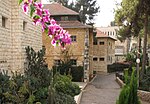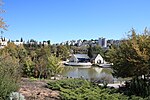Katamon

Katamon or Qatamon (Arabic: قطمون Katamun, Hebrew: קטמון, Greek: Καταμώνας Katamónas) is a neighborhood in south-central Jerusalem. The official Hebrew name, Gonen (גּוֹנֵן), is mainly used in municipal publications.Katamon is derived from the Greek κατὰ τῷ μοναστηρίῳ ("by the monastery"). The neighborhood is built next to an old Greek Orthodox monastery, believed to be built on the home and the tomb of Simeon from the Gospel of Luke. The neighborhood was established in the early 1900s, shortly before World War I as a wealthy, predominantly Palestinian Christian neighborhood. During the 1947–48 Civil War in Mandatory Palestine the local population fled the intense fighting in the area and were not allowed to return by the new Israeli state. Instead Katamon was soon repopulated by Jewish refugees.
Excerpt from the Wikipedia article Katamon (License: CC BY-SA 3.0, Authors, Images).Katamon
Hezkiyahu HaMelech, Jerusalem San Simon
Geographical coordinates (GPS) Address Nearby Places Show on map
Geographical coordinates (GPS)
| Latitude | Longitude |
|---|---|
| N 31.761 ° | E 35.207 ° |
Address
Hezkiyahu HaMelech
9323008 Jerusalem, San Simon
Jerusalem District, Israel
Open on Google Maps










